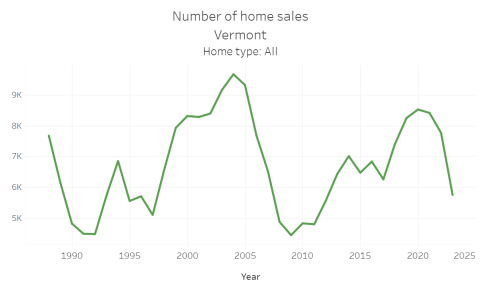
The median sales price of primary homes sold in Vermont reached $325,000 in 2023, increasing by 5% during that period compared to the prior year, according to recent Vermont Property Transfer Tax (PTT) records. This continues a trend in which no county in Vermont has seen a decline in annual home sale prices since 2019.
Among new homes sold in 2023, the median price statewide increased by 11% relative to the prior year, up to $616,500, according to data from the Multiple Listing Service.
In tandem with increasing prices, the annual number of primary homes sold has decreased each year since 2020. 5,759 homes were sold in 2023, more than 2,000 fewer than the prior year and 3,000 fewer than each year from 2019-2021. The number of homes sold in 2023 is the lowest annual total in Vermont since 2012 when the housing market was still dealing with the impacts of the Great Recession.
The tight nature of Vermont’s home sales market was also reflected in the median days that homes for sale were on the market. In 2023, the median number of days between when a home was listed for sale and when it was sold or went under contract fell to 62, continuing a multiyear trend of homes selling in less time each successive year.
These metrics, along with other indicators describing current and historic housing market conditions, are now available through 2023 for every Vermont community (town and county) on VHFA’s housingdata.org.
What is Property Transfer Tax (PTT) Data?
Vermont’s PTT is a tax collected by the Vermont Department of Taxes when property ownership is transferred between parties. This dataset is a reliable indicator of current market conditions as parties involved in all residential properties sales in the state must comply with this tax to confirm the title transfer and to be considered the valid owner of the property.
All title transfers, whether from sale or through the estate transfer process, are recorded through this means and are available through the state Department of Taxes website. The VHFA Community Relations & Research team collects, analyzes, and clarifies what the complex PTT data set might mean for our housing market, ultimately presenting it free-to-the-public on housingdata.org. Annual home sale figures are available on the site for all years since 1988.
Recent home price trends from PTT
The median Vermont home sold for $325,000 during 2023. Compared to a $309,000 median sale price for 2022, median sale prices increased 5% during the calendar year. This figure represents single-unit homes only used as primary residences and includes single-family detached homes, condominiums, and manufactured/mobile homes sold with land. Multi-unit buildings, undeveloped land, manufactured homes without land, and secondary homes are not included in the median price.
Home prices have increased consistently throughout the state in all counties since 2019, persisting through 2023. Aside from a slight decline in Lamoille County, no county in Vermont has seen any decline in annual median home sale price since prior to the outset of the Covid-19 pandemic. Since 2000, county home prices have fluctuated, with some even experiencing significant periods of decreasing median sale prices, especially prior to 2014.
Chittenden County continues to have the highest home prices in the state and the most consistent level of annual home price increase, with the median primary home selling for $460,500 in 2023 after increasing 6% from 2022. Chittenden County has seen price growth in every year this century, except 2009 and 2011 amidst the fallout of the Great Recession. Even so, fewer homes sold in Chittenden County in 2023 than any other year since 1988. Home sale volume has decreased in every county each year since 2020.
Notably, the median manufactured home (including factory-built homes) with land sold for $145,000, significantly lower than their “stick-built”/site-built counterparts. Manufactured homes sold without land (likely in a land-lease community sometimes referred to as a “mobile home park”) had a median sale price of $50,000 in 2023.
The lower sale price of manufactured homes, however, does not substantially impact statewide median home sale price figures because far fewer manufactured homes (162 with land, 165 without land) were sold compared to site-built homes (5,597 homes sold in 2023). While lesser in number, manufactured home sales trends are important in the context of broader conversations about affordable housing and environmental justice taking place currently in Vermont.
Additional Vermont home sales data
Using a combination of other data sources beyond PTT, housingdata.org site visitors can also view data exclusively for newly constructed homes. The median price of new homes has increased dramatically in the state since 2019, increasing from $365,569 up to $616,500 in 2023. This represents a 68% increase in the cost of a new home since the beginning of the Covid pandemic.
The dramatically increased cost of new housing is particularly notable in Vermont, as the state’s housing stock is amongst the oldest in the country. Nearly 26% of the homes in the state were built prior to 1939; more than 58% of the homes were built prior to 1980. While the age of a home is not a direct indicator of its quality, older homes require regular upkeep and are, in general, more likely to become unsafe for habitation. This highlights the need for continued maintenance and improvement of Vermont’s housing stock to prevent older homes from exiting the tight housing stock due to maintenance deferral.
The median length of time a Vermont home is on the market has continuously decreased every year since 2012. During 2023, the median home was sold in 62 days. In 2016, homes were on the market for twice as long, with a median of 137 days. This suggests that presently, the state continues to experience strong demand among homebuyers relative to the inventory of homes for sale.
Historically, certain aspects of the home sale market follow a seasonal cycle in Vermont. Most sales take place in the warmer spring and summer months. This is also when we see the greatest increase in home sale prices. This is born out in the data as the median number of days on market consistently increases during winter months. Despite an overall downward trend, the median length on market was 52 days in June 2023, but back up to 69 days in December. Days on market reached a relative high for the year in February at 82 days. Historically, February has the fewest home sales of any month in Vermont. Despite this, days on market is still significantly shorter even for the winter months, down from a median of 141 days in February 2019.
Vermont Housing Finance Agency (VHFA) programs are available to help moderate-income Vermonters become homeowners. In addition to its affordable mortgage and down payment assistance programs, VHFA also launched the Middle Income Homeownership Development Program to provide subsidies and incentives for homebuilders to construct or rehabilitate modest homes affordable to homebuyers at 120% area median income or lower. For more information and data analysis about current housing market conditions, explore more of the visualizations available on housingdata.org.

